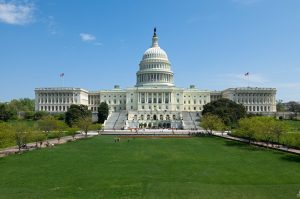The largest piece of tax reform since the Reagan administration is complete. The House of Representatives voted 224 to 201 in favor of the Republican-pushed tax plan on Wednesday, less than 24 hours following a 51-48 vote in favor of it in the Senate.
Nonprofits of all types face a brand new giving landscape following a doubling of both the standard deduction (up to $24,000 for couples and $12,000 for individuals) and the estate tax exemption (up to about $22 million for couples and $11 million for individuals). Other features include the maintaining of a staggered 1- or 2-percent excise tax on foundations depending on payout rates, the separate taxation of each unrelated business income tax as to not provide for offsetting between gains and losses, and the preservation of the Johnson Amendment – which prohibits partisan politicking by 501(c)(3) organizations.
The House originally approved the bill yesterday, but was forced to revote today following the Senate’s removal of three provisions following the initial House vote. One of the provisions related to a 1.4-percent tax on annual investment income of university endowments, applicable to universities with at least 500 students and per-student assets of $500,000 or more.
Berea College in Berea, Ky., was initially excluded from the tax before language related to “tuition-paying” universities was removed. Berea has a $1.1 billion endowment that helps support the college’s 1,600 students, none of whom pay tuition, according to a college spokesperson
“We agree that there need to be incentives for schools to make higher education accessible to all students, but it seems so unfortunate that the political strife over tax reform in our country will result in greater difficulty for colleges seeking to serve low-income students,” Lyle Roelofs, president of the college, said in a statement.
The excise tax is expected to apply to about 30 colleges and universities. An Association of American Universities spokesperson said that the association was in the process of helping administrators understand how provisions of the tax plan will likely be implemented.
Yale University, with an endowment of $27.2 billion, is no stranger to interest in its endowment, with state legislators eyeing taxation on the endowment last year. Peter Salovey, president of the university, voiced opposition to the federal tax in a statement earlier this month.
“I am deeply concerned that the idea of taxing universities’ investment income has passed the House as well as the Senate,” Salovey said. “Taxing universities will harm the country by taking away funds that would otherwise promote excellence in teaching and research, as well as financial aid . . . We should not be pursuing policies that create obstacles to spending on education and research, which drives economic growth, global competitiveness, and innovation that creates jobs.”
Jason Lee, chief advocacy and strategy officer for the Association of Fundraising Professionals (AFP), said that the association was pleased that the Johnson Amendment repeal, which was featured in the House’s original draft, was removed. Its inclusion would have undermined both donor intent and the intrinsic value of having a non-partisan charitable sector, he said.
Still, AFP leadership is disappointed in the doubled standard deduction without the aid of a universal charitable deduction. A universal deduction, both as an amendment to the tax bill and separate legislation, has garnered bipartisan support, according to Lee.
“A universal charitable deduction would have simplified the tax code and promoted fairness, allowing anyone to take a charitable deduction, whether they itemize or take a standard deduction,” Lee said in an email.
AFP is anticipating a reduction in itemizers of about 30 million on account of the standard deduction increase. About 82 percent of individual giving comes from itemizers, per Giving USA estimates, equating to an annual loss in giving of between $12 billion and $20 billion, he said.
The impact of the tax plan extends beyond charitable and foundation giving, according to David Thompson, vice president of public policy for the National Council of Nonprofits. Those two streams account for about 15 percent of nonprofit budgets combined. What council leadership and partners will concern themselves with in 2018 is the ripple effect the tax plan will have in state legislatures and on community organization budget sheets.
Even after a successful defense of the Johnson Amendment, which Thompson expects to come under attack again in the future, the council still opposed the tax bill because:
* Its increase on the standard deduction is expected to cut $13 billion out of giving annually, a sum that equates to between 220,000 and 260,000 jobs in the sector;
* Tax-exempt organizations are, in part, paying for tax cuts as entities such as large universities see their exempt status erode; and,
* The $1.5 trillion increase on the national deficit is likely to mean spending cuts that would likely have the effect of trickling down to the state level. About a third of state budgets are tied to federal dollars, Thompson said, and federal cuts are likely to lead to state cuts which are likely to lead to cuts in social programs.
“Getting work done is more important,” Thompson said when asked about the effect the plan would have on donations. “If agencies shut down, people will come next year. People come to [nonprofits] whether there is funding for that program or not. 2018 will be a year of reckoning.”
Much of the council’s work has traditionally been focused on state and local issues. Thompson expects a ripple effect to run through the states in 2018. States will be seeking to constrain eligibility for public assistance and to promulgate programs such as volunteer requirements in exchange for public benefits — something the council opposes.
State legislatures will also be looking for new revenue sources. Federal measures such as the tax plan’s 1.4-percent excise tax on about 30 universities with assets of $500,000 or more per student opens the door for federal and state officials to tax university endowments and other potential nonprofit entities such as hospitals and cultural institutions, Thompson said.
Dan Cardinali, president and CEO of Independent Sector (IS), foresees a similar 2018. IS leadership anticipates that an expanded federal deficit will place pressure across the system with federal dollars harder to come by for states and states seeking out additional funds all while cutting programming.
“It would surprise none of us if state legislatures will now be wrestling with similar ideas,” Cardinali said while discussing the federal tax plan’s excise tax on large universities.
A silver lining in the recent fight over tax reform has been improved coordination with sector partners such as the Council on Foundations, National Council of Nonprofits, Charitable Giving Coalition, and other entities, Cardinali said. Such relationships will serve IS in good stead in 2018 as leadership plans to continue recent battles such as the fight against the Johnson Amendment repeal and the promotion of a universal deduction.
IS leadership anticipates emphasizing polling that shows support against a Johnson Amendment repeal among both the public and sector leaders with federal representatives, Cardinali said. Similar efforts will be made in favor of a universal deduction. Cardinali opined that it is “fundamentally wrong” to limit the tax benefits of charitable giving to the very wealthy and that Congress missed an opportunity to incentivize giving across income levels.
“I think the headline is a massive transfer from civil society to corporate America in terms of wealth,” he said.
Hadar Susskind, senior vice president of government relations for the Council on Foundations, sees 2018 as a time to double-down on efforts relating to tax regulations. Susskind expects a tax-corrections act of sorts during 2018 to remove some of the unintended consequences and mistakes created by the tax plan’s accelerated process.
“We had a call the other day, the message for members was ‘This isn’t over by any means,’” said Susskind.
Three focuses for CoF in the coming year will be setting a flat foundation excise tax rate of 1 percent, facilitating individual retirement account (IRA) rollovers into donor-advised funds, and supporting a universal charitable deduction. The three will be pursued concurrently, though Susskind recognized that the universal deduction is the most significant of the three in terms of dollars and cents.
The flat private foundation excise tax has been a focus of CoF for several years. A House proposal to institute a flat 1.4-percent tax did not make it to the final bill. Susskind said that membership was divided between keeping the status quo – 1 percent if a foundation exceeds historical levels of grant-making or 2 percent otherwise – or the flat 1.4 percent. He said that he was somewhat surprised that Congress kept the status quo as the 1.4-percent tax was projected to increase federal revenue by $500 million during the life of the bill.
Susskind believes that the status quo might give the council a better opportunity to pursue a flat 1-percent tax than the House plan would have.
“We are closing a chapter here with the passing of the bill, but we’re just opening the next one,” he said.











